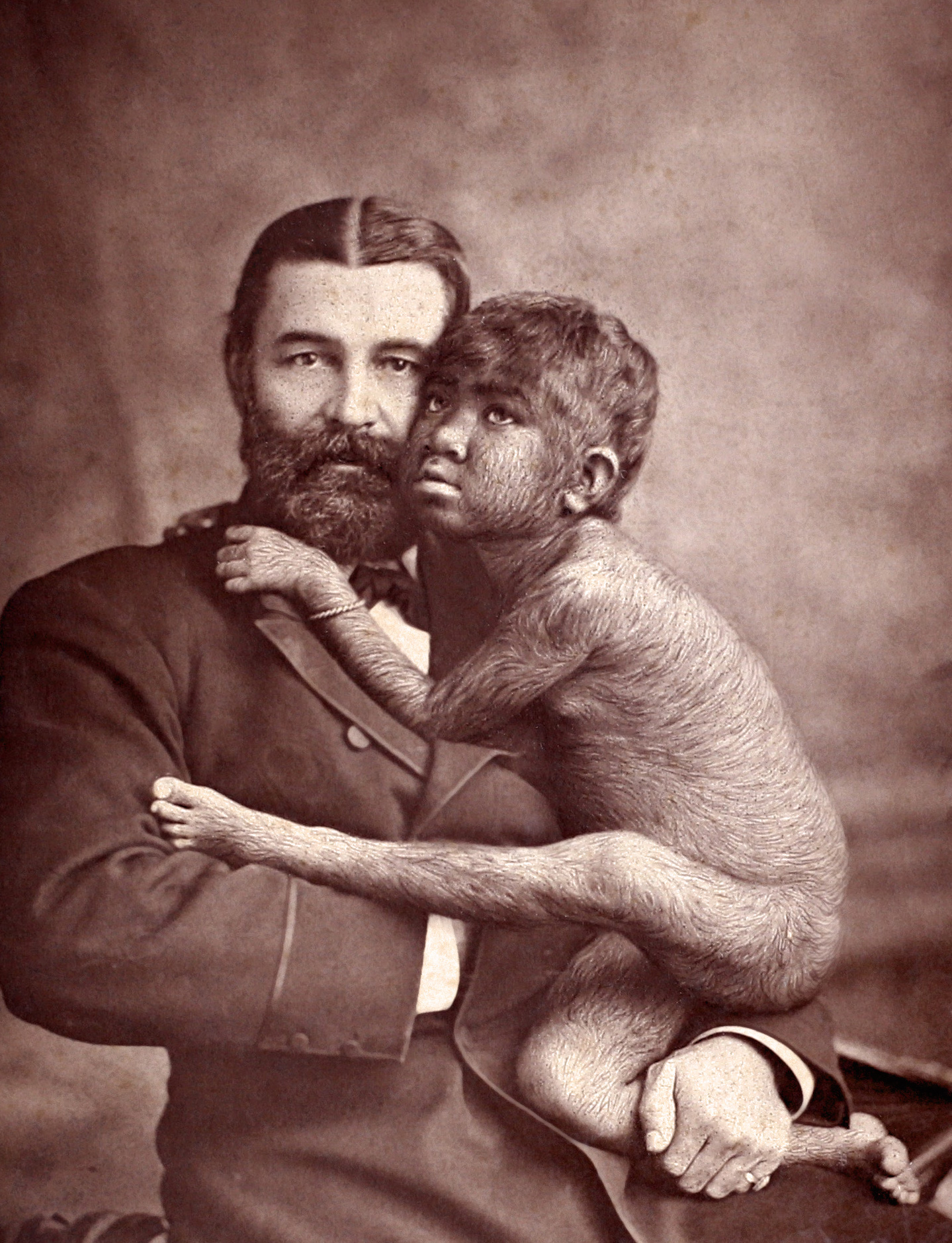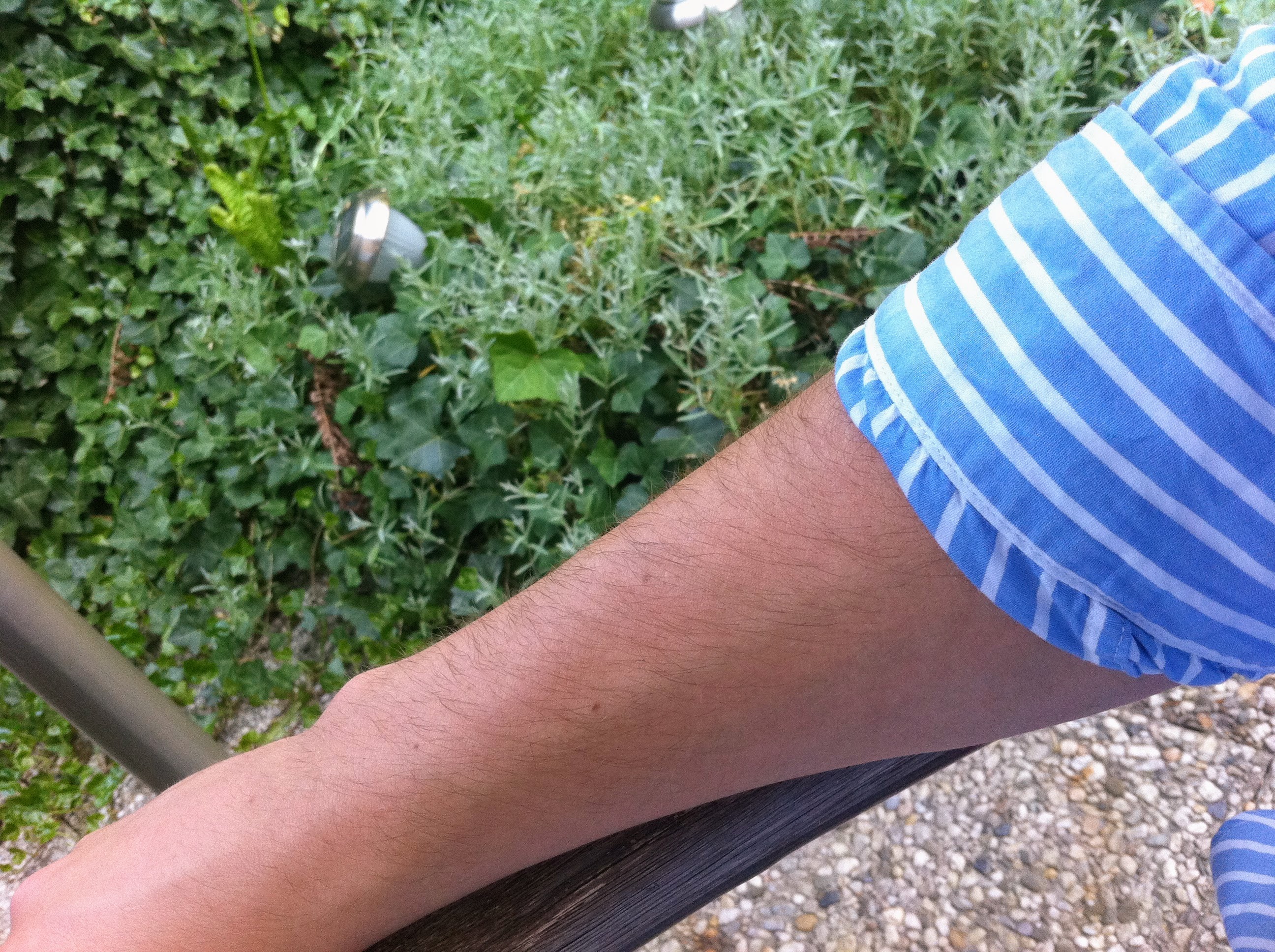|
Hypertrichosis
Hypertrichosis is an abnormal amount of hair growth over the body. The two distinct types of hypertrichosis are generalized hypertrichosis, which occurs over the entire body, and localized hypertrichosis, which is restricted to a certain area. Hypertrichosis can be either congenital (present at birth) or acquired later in life. The excess growth of hair occurs in areas of the skin with the exception of androgen-dependent hair of the pubic area, face, and axillary regions. Several circus sideshow performers in the 19th and early 20th centuries, such as Julia Pastrana, had hypertrichosis. Many of them worked as freaks and were promoted as having distinct human and animal traits. Classification Two methods of classification are used for hypertrichosis. One divides them into either generalized versus localized hypertrichosis, while the other divides them into congenital versus acquired. Congenital Congenital forms of hypertrichosis are caused by genetic mutations, and are ... [...More Info...] [...Related Items...] OR: [Wikipedia] [Google] [Baidu] |
Julia Pastrana
Julia Pastrana (August 1834 – 25 March 1860) was a performer and singer during the 19th century who had hypertrichosis. Pastrana, an indigenous woman from Mexico, was born in 1834, somewhere in the state of Sinaloa.Lerma Garay, Antonio. Érase una vez en Mazatlán. Comisión para la Celebración del Bicentenario de la Independencia y Centenario de la Revolución. Culiacán. 2010. She was born with a genetic condition, hypertrichosis terminalis (or generalized hypertrichosis lanuginosa); her face and body were covered with straight black hair. Her ears and nose were unusually large, and her teeth were irregular. The latter condition was caused by a rare disease, undiagnosed in her lifetime, gingival hyperplasia, which thickened her lips and gums. Life and career Multiple versions of Pastrana's early life exist. Literature produced by those who managed the freak shows she appeared in described her as belonging to a Native American tribe called "Root Diggers" whose members were sim ... [...More Info...] [...Related Items...] OR: [Wikipedia] [Google] [Baidu] |
Phenytoin
Phenytoin (PHT), sold under the brand name Dilantin among others, is an anti-seizure medication. It is useful for the prevention of tonic-clonic seizures (also known as grand mal seizures) and focal seizures, but not absence seizures. The intravenous form, fosphenytoin, is used for status epilepticus that does not improve with benzodiazepines. It may also be used for certain heart arrhythmias or neuropathic pain. It can be taken intravenously or by mouth. The intravenous form generally begins working within 30 minutes and is effective for roughly 24 hours. Blood levels can be measured to determine the proper dose. Common side effects include nausea, stomach pain, loss of appetite, poor coordination, increased hair growth, and enlargement of the gums. Potentially serious side effects include sleepiness, self harm, liver problems, bone marrow suppression, low blood pressure, and toxic epidermal necrolysis. There is evidence that use during pregnancy results in abnormalities ... [...More Info...] [...Related Items...] OR: [Wikipedia] [Google] [Baidu] |
Werewolf
In folklore, a werewolf (), or occasionally lycanthrope (; ; uk, Вовкулака, Vovkulaka), is an individual that can shapeshift into a wolf (or, especially in modern film, a therianthropic hybrid wolf-like creature), either purposely or after being placed under a curse or affliction (often a bite or the occasional scratch from another werewolf) with the transformations occurring on the night of a full moon. Early sources for belief in this ability or affliction, called lycanthropy (), are Petronius (27–66) and Gervase of Tilbury (1150–1228). The werewolf is a widespread concept in European folklore, existing in many variants, which are related by a common development of a Christian interpretation of underlying European folklore developed during the medieval period. From the early modern period, werewolf beliefs also spread to the New World with colonialism. Belief in werewolves developed in parallel to the belief in witches, in the course of the Late Middle ... [...More Info...] [...Related Items...] OR: [Wikipedia] [Google] [Baidu] |
Minoxidil
Minoxidil, sold under the brand name Rogaine among others, is a medication used for the treatment of high blood pressure and pattern hair loss. It is an antihypertensive vasodilator. It is available as a generic medication by prescription in oral tablet form and over the counter as a topical liquid or foam. Medical uses Minoxidil, when used for hypertension, is generally reserved for use in severe hypertension patients who can not respond to at least two agents and a diuretic. Minoxidil is also generally administered with a loop diuretic to prevent sodium and potassium retention. It may also cause a reflex tachycardia and thus is prescribed with a beta blocker. Minoxidil, applied topically, is widely used for the treatment of hair loss. It is effective in helping promote hair growth in people with androgenic alopecia regardless of sex. Minoxidil must be used indefinitely for continued support of existing hair follicles and the maintenance of any experienced hair regrowt ... [...More Info...] [...Related Items...] OR: [Wikipedia] [Google] [Baidu] |
Dermatology
Dermatology is the branch of medicine dealing with the skin.''Random House Webster's Unabridged Dictionary.'' Random House, Inc. 2001. Page 537. . It is a speciality with both medical and surgical aspects. A List of dermatologists, dermatologist is a specialist medical doctor who manages diseases related to skin, hair, nails, and some cosmetic problems. Etymology Attested in English in 1819, the word "dermatology" derives from the Ancient Greek, Greek δέρματος (''dermatos''), genitive of δέρμα (''derma''), "skin" (itself from δέρω ''dero'', "to flay") and -λογία ''wikt:-logia, -logia''. Neo-Latin ''dermatologia'' was coined in 1630, an anatomical term with various French and German uses attested from the 1730s. History In 1708, the first great school of dermatology became a reality at the famous Hôpital Saint-Louis in Paris, and the first textbooks (Willan's, 1798–1808) and atlases (Jean-Louis-Marc Alibert, Alibert's, 1806–1816) appeared in print ar ... [...More Info...] [...Related Items...] OR: [Wikipedia] [Google] [Baidu] |
Androgenic Hair
Body hair, or androgenic hair, is the terminal hair that develops on the human body during and after puberty. It is differentiated from the head hair and less visible vellus hair, which is much finer and lighter in color. The growth of androgenic hair is related to the level of androgens (often referred to as male hormones) and the density of androgen receptors in the dermal papillae. Both must reach a threshold for the proliferation of hair follicle cells. From childhood onward, regardless of sex, vellus hair covers almost the entire area of the human body. Exceptions include the lips, the backs of the ears, palms of hands, soles of the feet, certain external genital areas, the navel, and scar tissue. The density of hair – i.e. the number of hair follicles per unit area of skin – varies from person to person. In many cases, areas on the human body that contain vellus hair will begin to produce darker and thicker body hair during puberty, such as the first ... [...More Info...] [...Related Items...] OR: [Wikipedia] [Google] [Baidu] |
Porphyria Cutanea Tarda
Porphyria cutanea tarda is the most common subtype of porphyria. The disease is named because it is a porphyria that often presents with skin manifestations later in life. The disorder results from low levels of the enzyme responsible for the fifth step in heme production. Heme is a vital molecule for all of the body's organs. It is a component of hemoglobin, the molecule that carries oxygen in the blood. Hepatoerythropoietic porphyria has been described as a homozygous form of porphyria cutanea tarda, although it can also be caused if two different mutations occur at the same locus. Symptoms and signs Porphyria cutanea tarda (PCT) is recognized as the most prevalent subtype of porphyritic diseases. PCT is characterized by onycholysis and blistering of the skin in areas that receive higher levels of exposure to sunlight. The primary cause is a deficiency of uroporphyrinogen decarboxylase (UROD), a cytosolic enzyme that is a step in the enzymatic pathway that leads to the synt ... [...More Info...] [...Related Items...] OR: [Wikipedia] [Google] [Baidu] |
Nucleotide
Nucleotides are organic molecules consisting of a nucleoside and a phosphate. They serve as monomeric units of the nucleic acid polymers – deoxyribonucleic acid (DNA) and ribonucleic acid (RNA), both of which are essential biomolecules within all life-forms on Earth. Nucleotides are obtained in the diet and are also synthesized from common nutrients by the liver. Nucleotides are composed of three subunit molecules: a nucleobase, a five-carbon sugar ( ribose or deoxyribose), and a phosphate group consisting of one to three phosphates. The four nucleobases in DNA are guanine, adenine, cytosine and thymine; in RNA, uracil is used in place of thymine. Nucleotides also play a central role in metabolism at a fundamental, cellular level. They provide chemical energy—in the form of the nucleoside triphosphates, adenosine triphosphate (ATP), guanosine triphosphate (GTP), cytidine triphosphate (CTP) and uridine triphosphate (UTP)—throughout the cell for the many c ... [...More Info...] [...Related Items...] OR: [Wikipedia] [Google] [Baidu] |
Terminal Hair
In humans, terminal hair is a variant of hair that is thick and long such as what grows on the scalp, as compared with vellus hair, colloquially known as peach fuzz, growing elsewhere.Marks, James G; Miller, Jeffery (2006)''Lookingbill and Marks' Principles of Dermatology''(4th ed.), Elsevier Inc., p. 11. During puberty, the increase in androgenic hormone levels causes vellus hair to be replaced with terminal hair in certain parts of the human body.Hiort, O. "Androgens and Puberty". ''Best Practice & Research Clinical Endocrinology & Metabolism'', Vol. 16, No. 1, pp. 31–41. These parts will have different levels of sensitivity to androgens, primarily of the testosterone family.Neal, Matthew; Lauren M. Sompayrac''How the Endocrine System Works'' Blackwell Publishing, 2001, p. 75. The pubic area is particularly sensitive to such hormones, as are the armpits which will develop axillary hair.Randall, Valerie A.; Nigel A. Hibberts, M. Julie Thornton, Kazuto Hamada, Alison E. M ... [...More Info...] [...Related Items...] OR: [Wikipedia] [Google] [Baidu] |
Chromosome 17
Chromosome 17 is one of the 23 pairs of chromosomes in humans. People normally have two copies of this chromosome. Chromosome 17 spans more than 83 million base pairs (the building material of DNA) and represents between 2.5 and 3% of the total DNA in cells. Chromosome 17 contains the Homeobox B gene cluster. Genes Number of genes The following are some of the gene count estimates of human chromosome 17. Because researchers use different approaches to genome annotation their predictions of the number of genes on each chromosome varies (for technical details, see gene prediction). Among various projects, the collaborative consensus coding sequence project ( CCDS) takes an extremely conservative strategy. So CCDS's gene number prediction represents a lower bound on the total number of human protein-coding genes. Gene list The following is a partial list of genes on human chromosome 17. For complete list, see the link in the infobox on the right. The following are som ... [...More Info...] [...Related Items...] OR: [Wikipedia] [Google] [Baidu] |
Anorexia Nervosa
Anorexia nervosa, often referred to simply as anorexia, is an eating disorder characterized by underweight, low weight, Calorie restriction, food restriction, body image disturbance, fear of gaining weight, and an overpowering desire to be thin. ''Anorexia'' is a term of Greek origin: ''an-'' (ἀν-, prefix denoting negation) and ''orexis'' (ὄρεξις, "appetite"), translating literally to "a loss of appetite"; the adjective ''nervosa'' indicating the functional and non-organic nature of the disorder. ''Anorexia nervosa'' was coined by Gull in 1873 but, despite literal translation, the feeling of hunger is frequently present and the pathological control of this instinct is a source of satisfaction for the patients. Individuals with anorexia nervosa have a fear of being overweight or being seen as such, although they are in fact underweight. The DSM-5 describes this perceptual symptom as "disturbance in the way in which one's body weight or shape is experienced". In resea ... [...More Info...] [...Related Items...] OR: [Wikipedia] [Google] [Baidu] |
MAP2K6
Dual specificity mitogen-activated protein kinase kinase 6 also known as MAP kinase kinase 6 (MAPKK 6) or MAPK/ERK kinase 6 is an enzyme that in humans is encoded by the ''MAP2K6'' gene, on chromosome 17. Function MAPKK 6 is a member of the dual specificity protein kinase family, which functions as a mitogen-activated protein (MAP) kinase kinase. MAP kinases, also known as extracellular signal-regulated kinases (ERKs), act as an integration point for multiple biochemical signals. This protein phosphorylates and activates p38 MAP kinase in response to inflammatory cytokines or environmental stress. As an essential component of p38 MAP kinase mediated signal transduction pathway, this gene is involved in many cellular processes such as stress-induced cell cycle arrest, transcription activation and apoptosis. Interactions MAP2K6 has been shown to interact with TAOK2, ASK1, MAPK14 and MAP3K7 Mitogen-activated protein kinase kinase kinase 7 (MAP3K7), also known as TAK1 ... [...More Info...] [...Related Items...] OR: [Wikipedia] [Google] [Baidu] |






.jpg)